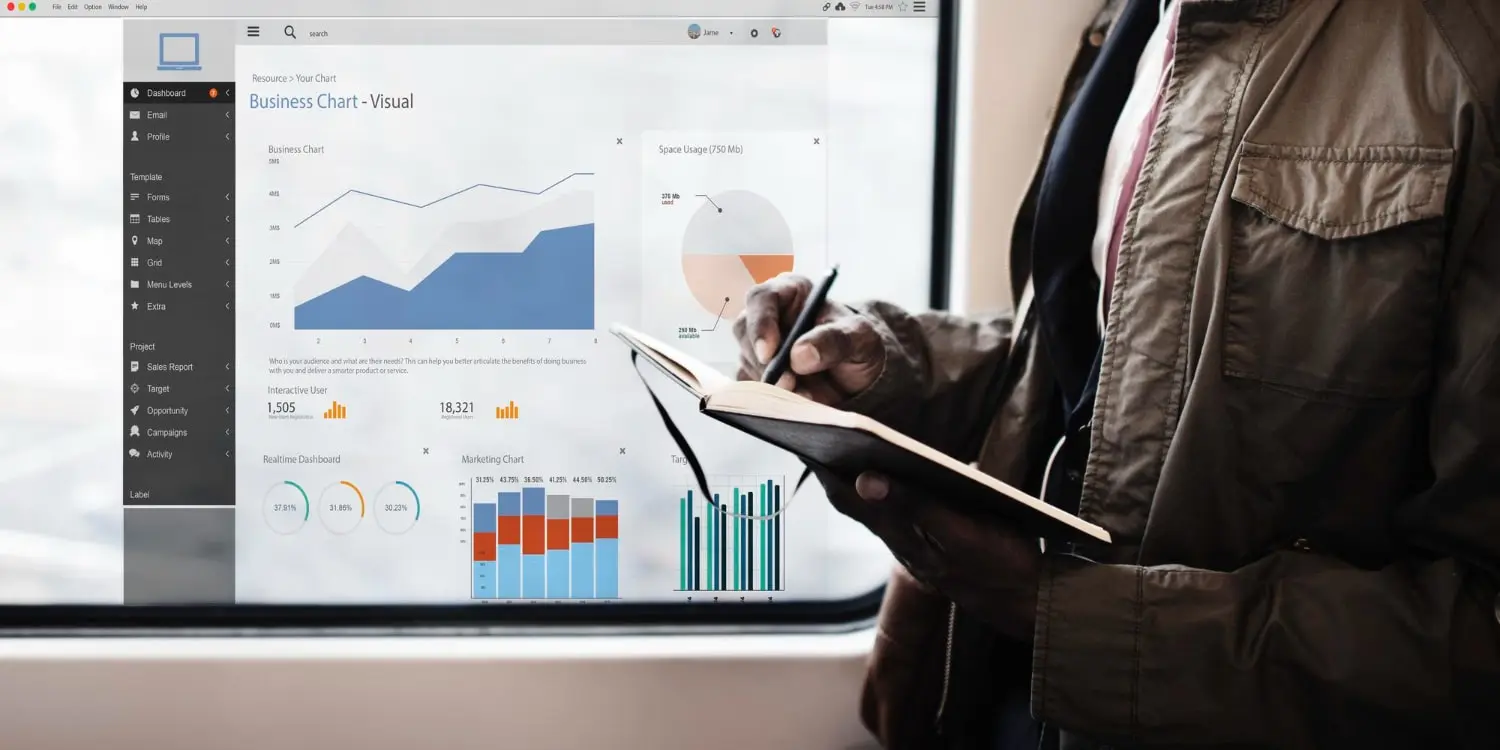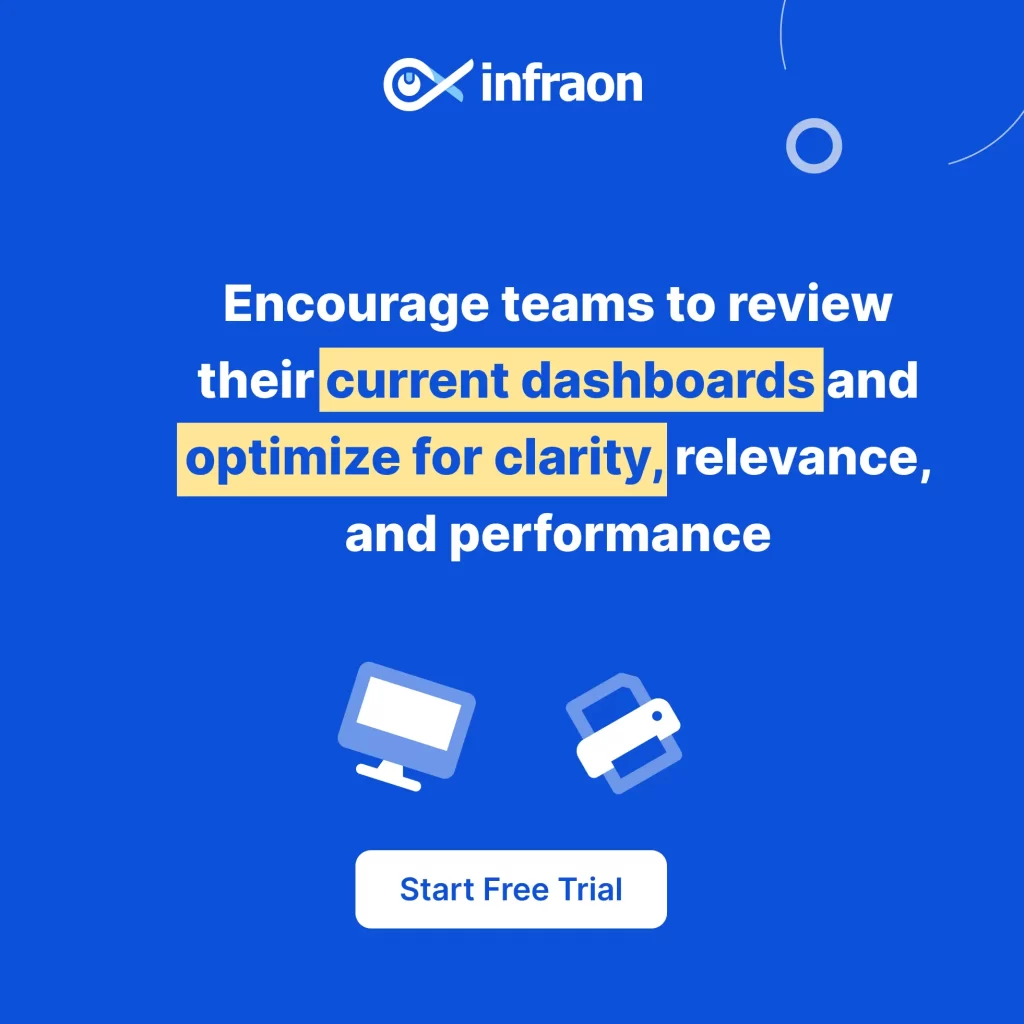Monitoring dashboards are now essential for performance tracking and smart, data-driven decisions. But just having a dashboard isn’t enough—clarity, usability, and thoughtful design make all the difference. An effective dashboard should highlight the right metrics and offer real-time, actionable insights. With Infraon’s advanced tools, businesses can create powerful monitoring dashboards that simplify complex data and support better decisions.
What is a Monitoring Dashboard?
A monitoring dashboard is a visual tool that tracks key metrics in real time, helping teams stay on top of performance and detect issues quickly. Unlike general dashboards, which often focus on reporting and historical trends, monitoring dashboards are built for constant oversight and fast response. They offer a clear snapshot of what’s happening now, not just what happened before. Whether it’s an IT infrastructure dashboard, business KPI dashboard, or network monitoring tool, an effective dashboard is designed for clarity, speed, and action. With effective dashboard design, you can highlight the most critical data, reduce noise, and support smarter, faster decisions.
Why Do You Need an Effective Dashboard?
Creating effective dashboards is key to staying ahead in fast-paced business environments. They bring clarity, speed, and alignment across teams by showing the right data at the right time.

- Quick decision-making based on real-time data: Effective dashboards give you instant insights, helping leaders act quickly without waiting for reports.
- Detecting performance issues early: By building effective dashboards, teams can spot issues before they grow, keeping operations smooth.
- Enhancing operational visibility across departments: Dashboards give every team a clear view of performance, promoting better coordination and understanding.
- Aligning teams with key metrics: Everyone stays focused on shared goals when key numbers are easy to track and understand.
- Reducing manual reporting efforts: Automated dashboards save time by cutting down the need for manual updates and report creation.
Principles of Effective Dashboard Design
A well-designed dashboard makes complex data easy to understand at a glance. It’s all about showing the right information in the right way, without overwhelming the user.
- Clarity over complexity: reducing clutter: Avoid too much information on one screen. A clean, focused layout helps users stay on track.
- Prioritizing key metrics and KPIs: Only show what matters most. Highlight the top KPIs that support fast decisions.
- Using visual hierarchy and intuitive layout: Place the most important data at the top or center. Group related metrics together for easy reading.
- Choosing the right data visualization: Pick visuals that match the data—use line graphs for trends, bars for comparisons, and gauges for limits.
- Color coding and alert signals for immediate interpretation: Use red, yellow, and green to show urgency. This helps teams spot problems instantly.
- Mobile and responsive design considerations: Design for all screen sizes. Dashboards should work just as well on phones and tablets.
How to Build an Effective Dashboard: Step-by-Step
Building effective dashboards takes planning and the right tools. The goal is to create monitoring dashboards that are simple, accurate, and useful for daily operations.
- Identify user roles and what data they need: Start by understanding who will use the dashboard and what information they need to see.
- Define clear goals and KPIs: Set clear objectives and choose KPIs that truly reflect performance and success.
- Choose the right tools/platforms (e.g., Grafana, Power BI, Motadata): Pick platforms that fit your team’s needs and are easy to integrate and maintain.
- Integrate reliable data sources: Make sure your dashboard pulls real-time, accurate data from trusted systems.
- Use templates or frameworks for creating effective dashboards: Templates help speed up setup and ensure consistency across all monitoring dashboards.
- Set up automated updates and refresh cycles: Automate data refreshes so users always see the latest information without delay.
- Test usability and iterate based on feedback: Gather user input, test the layout, and keep improving the dashboard over time.
Common Mistakes to Avoid in Dashboard Design
Even the best tools can fall short if the design isn’t right. When creating monitoring dashboards, it’s important to avoid these common mistakes that reduce clarity and value.

- Overloading with too much information: Too many charts or metrics on one screen can confuse users. A good dashboard for monitoring performance should stay focused on what truly matters.
- Using inconsistent or confusing visual elements: Different colors, fonts, or chart types across the dashboard create distraction. Keep the visuals clean and consistent.
- Ignoring end-user needs and workflows: If the dashboard doesn’t match how users work, it won’t be helpful. Design around real user tasks and roles.
- Lack of interactivity or customization: Users should be able to filter or explore data. Without that, monitoring dashboards can feel limited and less useful.
- No context provided for data (e.g., benchmark values, thresholds): Data alone isn’t enough. Always show comparisons, limits, or benchmarks to give meaning to the numbers.
Real-World Applications of Monitoring Dashboards
Monitoring dashboards are used across many industries to track performance, spot issues, and support faster decisions. An effective dashboard helps teams stay informed and take the right action at the right time.
- IT and network monitoring: server health, uptime, load tracking: Teams use monitoring dashboards to track server status, network uptime, and system load to prevent downtime.
- Business operations: sales, revenue, customer support metrics: An effective dashboard gives real-time updates on sales, revenue trends, and support team performance.
- DevOps: CI/CD pipelines, application errors, deployment metrics: Monitoring dashboards help DevOps teams keep an eye on deployments, error rates, and pipeline efficiency.
- Marketing: campaign performance, web traffic analytics: Track campaign results and website visits through dashboards that show what’s working and what needs improvement.
- Healthcare: patient monitoring dashboards: In hospitals, dashboards track patient vitals and alerts, helping staff respond quickly and improve care.
Best Practices for Creating Effective Dashboards
To get the most out of monitoring dashboards, it’s important to follow simple yet thoughtful steps. These best practices ensure effective dashboard design that delivers real value to your team.

- Focus on user-centric design: Design dashboards around what users really need to see and do, not just the available data.
- Start small: pilot dashboards for core teams: Begin with a basic version for a key team, test it, and improve based on feedback.
- Align dashboards with organizational goals: Each dashboard should support specific business goals and keep teams focused on results.
- Regularly review and refine metrics: Make time to check if the right metrics are being tracked and remove anything unnecessary.
- Ensure real-time data sync and minimal latency: Fast, live updates are key—especially for monitoring dashboards where timing matters.
- Train teams on dashboard interpretation and actionability: Make sure users understand the data and know how to act on what they see.
How Monitoring Dashboards Drive Business Performance
Monitoring dashboards are more than just data—they help teams act faster, plan better, and stay aligned. A well-built dashboard brings real-time insights to drive stronger business outcomes.
- Enabling proactive monitoring and faster response times: Teams can spot issues early and fix them before they impact operations.
- Improving cross-functional collaboration through shared data: Shared dashboards help teams across departments work together with the same data view.
- Supporting strategic planning with historical trends: An effective dashboard design includes past data to guide long-term business planning.
- Enhancing customer satisfaction with service-level visibility: By tracking response times and service metrics, dashboards help improve customer experience.
- Real example of business impact using an effective dashboard: A retail company used a live sales dashboard to catch slow-moving products early—helping them adjust marketing and boost sales within weeks.
Conclusion
Building effective dashboards is key to tracking performance, making faster decisions, and staying ahead of problems. When designed thoughtfully with accurate data and user-friendly layouts, monitoring dashboards become powerful tools for every team. Infraon helps businesses create smart, easy-to-use dashboards that bring clarity, real-time insights, and better control across operations. With Infraon, you can turn data into action and drive stronger business outcomes every day.
FAQ
What is a monitoring dashboard used for?
A monitoring dashboard is used to track real-time performance metrics, detect issues early, and provide a clear view of operations. It helps teams monitor systems, processes, or business functions, ensuring timely decisions and better control across departments.
What makes a dashboard effective?
An effective dashboard is clear, focused, and easy to use. It highlights key metrics, avoids clutter, uses the right visuals, and updates in real-time. Good design and usability help users quickly understand data and take action when needed.
How do I choose the right metrics for my dashboard?
Start by understanding your team’s goals and user roles. Choose metrics that reflect performance, support decisions, and align with business objectives. Avoid tracking too much—focus only on what matters most for daily operations and long-term success.
What are the best tools for building dashboards?
Popular tools for building dashboards include Power BI, Grafana, and Motadata. Infraon also offers powerful solutions tailored for monitoring dashboards, combining real-time data, easy setup, and user-friendly design to meet diverse business needs.
How often should dashboards be updated or reviewed?
Dashboards should update in real time or at regular intervals, depending on your needs. Review the setup monthly or quarterly to ensure metrics stay relevant, visuals remain clear, and the dashboard continues supporting business goals effectively.




















